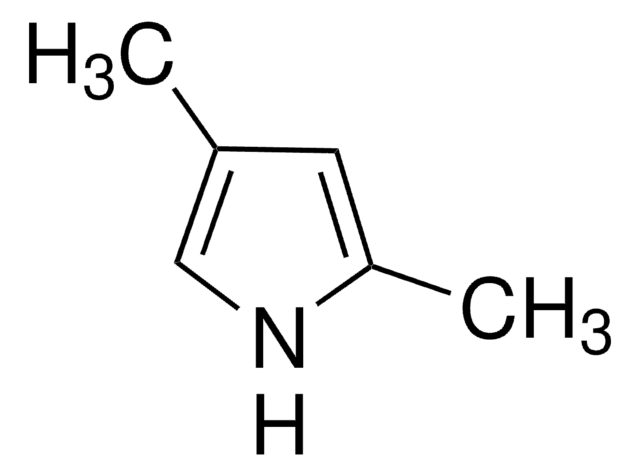746169
Difluoro(4-(1,1-dimethylethyl)-2-{1-[4-(1,1-dimethylethyl)-3,5-dimethyl-2H-pyrrol-2-ylidene-N]ethyl}-3,5-dimethyl-1H-pyrrol-2-ylidene-N]ethyl}-3,5-dimethyl-1H-pyrrolato-N)boron
98% (HPLC)
Synonyme(s) :
Boron,[4-(1,1-dimethylethyl)-2-[1-[4-(1,1-dimethylethyl)-3,5-dimethyl-2H-pyrrol-2-ylidene]ethyl]-3,5-dimethyl-1H-pyrrolato-N1,N2]difluoro-, PM 570, PM 596, PM 597, Pyrromethene 570, Pyrromethene 596, Pyrromethene 597
About This Item
Produits recommandés
Pureté
98% (HPLC)
Forme
powder
Pf
256-261 °C
λmax
526 nm in dichloromethane
Chaîne SMILES
CC(C1=C(C)C(C(C)(C)C)=C(C)N1B(F)2F)=C3[N]2=C(C)C(C(C)(C)C)=C3C
InChI
1S/C22H33BF2N2/c1-12-17(21(6,7)8)15(4)26-19(12)14(3)20-13(2)18(22(9,10)11)16(5)27(20)23(26,24)25/h1-11H3
Clé InChI
SEHGNHOGQDPQRC-UHFFFAOYSA-N
Catégories apparentées
Description générale
Application
Also used for solid-state dye laser devices and organic solar cells.
Code de la classe de stockage
11 - Combustible Solids
Classe de danger pour l'eau (WGK)
WGK 3
Point d'éclair (°F)
Not applicable
Point d'éclair (°C)
Not applicable
Certificats d'analyse (COA)
Recherchez un Certificats d'analyse (COA) en saisissant le numéro de lot du produit. Les numéros de lot figurent sur l'étiquette du produit après les mots "Lot" ou "Batch".
Déjà en possession de ce produit ?
Retrouvez la documentation relative aux produits que vous avez récemment achetés dans la Bibliothèque de documents.
Les clients ont également consulté
Notre équipe de scientifiques dispose d'une expérience dans tous les secteurs de la recherche, notamment en sciences de la vie, science des matériaux, synthèse chimique, chromatographie, analyse et dans de nombreux autres domaines..
Contacter notre Service technique
![Difluoro{2-[1-(3,5-dimethyl-2H-pyrrol-2-ylidene-N)ethyl]-3,5-dimethyl-1H-pyrrolato-N}boron 99% (HPLC)](/deepweb/assets/sigmaaldrich/product/structures/196/394/4c2c0eae-f749-44bf-a37b-84bf0226092e/640/4c2c0eae-f749-44bf-a37b-84bf0226092e.png)
![Difluoro{2-[(3,5-dimethyl-2H-pyrrol-2-ylidene-N)methyl]-3,5-dimethyl-1H-pyrrolato-N}boron 99% (HPLC)](/deepweb/assets/sigmaaldrich/product/structures/518/861/c19c64be-654e-472e-a069-30ffccb1a8cd/640/c19c64be-654e-472e-a069-30ffccb1a8cd.png)







